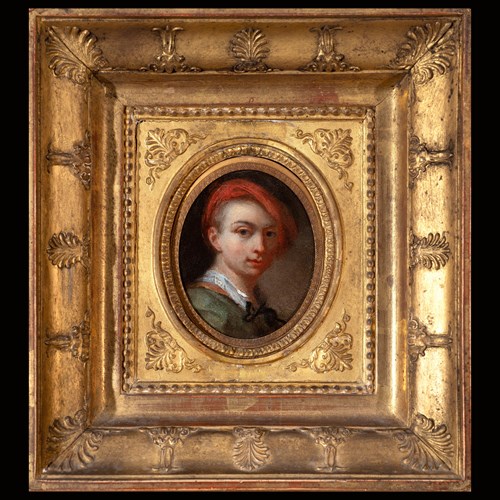Marketplace
Portrait miniature of a Young Lady wearing a chemise dress with a pink bow at her décolletage and a pink sash at her waist, her hair powdered and topped with a white ribbon or cap; circa 1785
OZIAS HUMPHRY
Portrait miniature of a Young Lady wearing a chemise dress with a pink bow at her décolletage and a pink sash at her waist, her hair powdered and topped with a white ribbon or cap; circa 1785
The Limner Company : Portrait Miniature
Date Circa 1785
Medium Watercolour on ivory
Dimension 5.4 cm (2¹/₈ inches)
This portrait of a young lady exhibits the modes of fashionable female portraiture of the late eighteenth century. The landscape setting and her chemise dress are characteristic of the trends of the 1780s. It is closely comparable, for example, to a portrait by the artist’s close friend, George Romney (1734-1802) or Mrs Mark Currie [Tate, N01651].
The genteel young sitter wears the highly fashionable, chemise à la reine, so called because it was popularised by Marie Antoinette (1755-1793). When the French Queen eschewed regal attire for this unconscionably informal, relatively structureless attire (which resembled women’s undergarments) in a formal portrait by Elisabeth Vigée Le Brun (1755–1842) [National Gallery of Art, Washington, accession no. 1960.6.41], it caused a scandal and was soon circulated far and wide by the recent innovation of the fashion plate as well as cartoons by popular press. The chemise dress became arguably the most significant garment of late-eighteenth/early nineteenth-century womenswear, with far-reaching sartorial, social and political influences.
English women adopted the chemise quicker than the French, and it fit neatly with the British concern for fashion inspired by practicality and outdoor pursuits. At the same time, portraiture itself had begun to look outdoors with the recent British tradition among the landowning gentry choosing to have their portrait set within a landscape, often topographical. There is also the inescapable, long-standing convention in female portraiture of setting women in a verdant or floral setting to signify fertility and perhaps serenity and innocence. Writer, Fanny Burney (1752-1840) pervades this notion in the preface to Evelina (1778):
The heroine of these memoirs, young, artless,
and inexperience, is
No, faultless Monster, that the World ne’er saw,
But the offspring of Nature, and of Nature in
Her simplest attire.[1]
As a young teenager, Humphry studied at William Shipley’s drawing school with his contemporaries, John Smart (1741-1811) and Richard Cosway (1742-1821). Alongside Smart and Cosway, he would become one of the most successful miniaturists of the late-eighteenth century, enjoying the patronage of the royal family and gaining lucrative commissions in the British colonial establishment in India. A very fine draughtsman, he was appointed Portrait Painter in Crayons to King George III in 1792. He also numbers among few miniaturists to have been elected a full member of the Royal Academy.
[1] Quoted in Shawe-Taylor, D., The Georgians: Eighteenth-Century Portraiture and Society, 1990, p.127
The genteel young sitter wears the highly fashionable, chemise à la reine, so called because it was popularised by Marie Antoinette (1755-1793). When the French Queen eschewed regal attire for this unconscionably informal, relatively structureless attire (which resembled women’s undergarments) in a formal portrait by Elisabeth Vigée Le Brun (1755–1842) [National Gallery of Art, Washington, accession no. 1960.6.41], it caused a scandal and was soon circulated far and wide by the recent innovation of the fashion plate as well as cartoons by popular press. The chemise dress became arguably the most significant garment of late-eighteenth/early nineteenth-century womenswear, with far-reaching sartorial, social and political influences.
English women adopted the chemise quicker than the French, and it fit neatly with the British concern for fashion inspired by practicality and outdoor pursuits. At the same time, portraiture itself had begun to look outdoors with the recent British tradition among the landowning gentry choosing to have their portrait set within a landscape, often topographical. There is also the inescapable, long-standing convention in female portraiture of setting women in a verdant or floral setting to signify fertility and perhaps serenity and innocence. Writer, Fanny Burney (1752-1840) pervades this notion in the preface to Evelina (1778):
The heroine of these memoirs, young, artless,
and inexperience, is
No, faultless Monster, that the World ne’er saw,
But the offspring of Nature, and of Nature in
Her simplest attire.[1]
As a young teenager, Humphry studied at William Shipley’s drawing school with his contemporaries, John Smart (1741-1811) and Richard Cosway (1742-1821). Alongside Smart and Cosway, he would become one of the most successful miniaturists of the late-eighteenth century, enjoying the patronage of the royal family and gaining lucrative commissions in the British colonial establishment in India. A very fine draughtsman, he was appointed Portrait Painter in Crayons to King George III in 1792. He also numbers among few miniaturists to have been elected a full member of the Royal Academy.
[1] Quoted in Shawe-Taylor, D., The Georgians: Eighteenth-Century Portraiture and Society, 1990, p.127
Date: Circa 1785
Medium: Watercolour on ivory
Signature: Signed on the reverse.
Dimension: 5.4 cm (2¹/₈ inches)
Provenance: Ellison Fine Art, 2010;
Private Collection, UK.
More artworks from the Gallery





, wearing a black doublet, fur-lined gown and black cap after _T638816158087560184.JPG?width=500&height=500&mode=pad&scale=both&qlt=90&format=jpg)
-Portrait miniature of a Marshal of France, probably Marshal Louis Francis, Duc d’Boufflers (1644-1711) wearing arm_T638688409312186961.JPG?width=500&height=500&mode=pad&scale=both&qlt=90&format=jpg)


